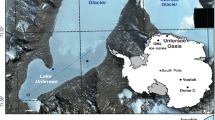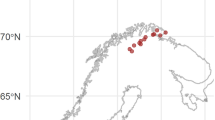Abstract
Perennial ice covers on many Antarctic lakes have resulted in high lake inorganic carbon contents. The objective of this paper was to evaluate and compare the brine and CO2 chemistries of Lake Vida (Victoria Valley) and West Lake Bonney (Taylor Valley), two lakes of the McMurdo Dry Valleys (East Antarctica), and their potential consequences during global warming. An existing geochemical model (FREZCHEM-15) was used to convert measured molarity into molality needed for the FREZCHEM model, and this model added a new algorithm that converts measured DIC into carbonate alkalinity needed for the FREZCHEM model. While quite extensive geochemical information exists for ice-covered Taylor Valley lakes, such as West Lake Bonney, only limited information exists for the recently sampled brine of >25 m ice-thick Lake Vida. Lake Vida brine had a model-calculated pCO2 = 0.60 bars at the field pH (6.20); West Lake Bonney had a model-calculated pCO2 = 5.23 bars at the field pH (5.46). Despite the high degree of atmospheric CO2 supersaturation in West Lake Bonney, it remains significantly undersaturated with the gas hydrate, CO2·6H2O, unless these gas hydrates are deep in the sediment layer or are metastable having formed under colder temperatures or greater pressures. Because of lower temperatures, Lake Vida could start forming CO2·6H2O at lower pCO2 values than West Lake Bonney; but both lakes are significantly undersaturated with the gas hydrate, CO2·6H2O. For both lakes, simulation of global warming from current subzero temperatures (−13.4 °C in Lake Vida and −4.7 °C in West Lake Bonney) to 10 °C has shown that a major loss of solution-phase carbon as CO2 gases and carbonate minerals occurred when the temperatures rose above 0 °C and perennial ice covers would disappear. How important these Antarctic CO2 sources will be for future global warming remains to be seen. But a recent paper has shown that methane increased in atmospheric concentration due to deglaciation about 10,000 years ago. So, CO2 release from ice lakes might contribute to atmospheric gases in the future.



Similar content being viewed by others
References
Brosius LS, Walter Anthony KM, Grosse G, Chanton JP, Farquharson LM, Overduin PP, Meyer H (2012) Using the deuterium isotope composition of permafrost meltwater to constrain thermokarst lake contributions to atmospheric CH4 during the last deglaciation. J Geophys Res 117:G01022. doi:10.1029/2011JG001810
Buffett BA, Zatsepina OY (1999) Metastability of gas hydrates. Geophys Res Lett 26:2981–2984
Doran PT, Wharton RA Jr, Lyons WB (1994) Paleolimnology of the McMurdo Dry Valleys, Antarctica. J Paleolimol 10:85–114
Doran PT, Fritsen CH, McKay CP, Priscu JC, Adams EE (2003) Formation and character of an ancient 19-m ice cover and underlying trapped brine in an “ice-sealed” east Antarctic lake. Proc Natl Acad Sci USA 100:26–31
Doran PT, Fritsen CH, Murray AE, Kenig F, McKay CP, Kyne JD (2008) Entry approach into pristine ice-sealed lakes—Lake Vida, East Antarctica, a model ecosystem. Limnol Oceanogr Methods 6:542–547
Hattermann T, Levermann A (2010) Response of Southern Ocean circulation to global warming may enhance basal ice shelf melting around Antarctica. Clim Dyn 35:741–756
Joughin I, Alley RB (2011) Stability of the West Antarctic ice sheet in a warming world. Nat Geosci 4:506–513
Knoepfle JL, Doran PT, Kenig F, Lyons WB, Galchenko VF (2009) Particulate organic and dissolved inorganic carbon stable isotopic composition in Taylor Valley lakes, Antarctica: the effect of legacy. Hydrobiologia 632:139–156
Lyons WB, Welch KA, Snyder G, Olesik J, Graham EY, Marion GM, Poreda RJ (2005) Halogen geochemistry of the McMurdo dry valleys lakes, Antarctica: clues to the origin of solutes and lake evolution. Geochim Cosmochim Acta 69:305–323
Marion GM (1997) A theoretical evaluation of mineral stability in Don Juan Pond, Wright Valley, Victoria Land. Antarct Sci 9:92–99
Marion GM (2001) Carbonate mineral solubility at low temperatures in the Na–K–Mg–Ca–H–Cl–SO4–OH–HCO3–CO3–CO2–H2O system. Geochim Cosmochim Acta 65:1883–1896
Marion GM (2007) Adapting molar data (without density) for molal models. Comput Geosci 33:829–834
Marion GM, Farren RE (1999) Mineral solubilities in the Na–K–Mg–Ca–Cl–SO4–H2O system: a re-evaluation of the sulfate chemistry in the Spencer-Møller-Weare model. Geochim Cosmochim Acta 63:1305–1318
Marion GM, Kargel JS (2008) Cold aqueous planetary geochemistry with FREZCHEM: from modeling to the search for life at the limits. Springer, Berlin
Marion GM, Kargel JS, Catling DC, Jakubowski SD (2005) Effects of pressure on aqueous chemical equilibria at subzero temperatures with applications to Europa. Geochim Cosmochim Acta 69:259–274
Marion GM, Catling DC, Kargel JS (2006) Modeling gas hydrate equilibria in electrolyte solutions. CALHAD 30:248–259
Marion GM, Millero FJ, Camões MF, Spitzer P, Feistel R, Chen C-TA (2011) pH of seawater. Marine Chem 126:89–96
Marion GM, Kargel JS, Catling DC, Lunine JI (2012) Modeling ammonia-ammonium chemistries in the Solar System’s icy bodies. Icarus 220:932–946
McKay CP, Hand KP, Doran PT, Andersen DT, Priscu JC (2003) Clathrate formation and the fate of noble and biologically useful gases in Lake Vostok, Antarctica. Geophys Res Lett 30(13):1702. doi:101029/2003GL017490
Millero FJ, Feistel R, Wright DG, McDougall TJ (2008) The composition of standard seawater and the definition of the reference-composition salinity scale. Deep Sea Res 55:50–72
Murray AE, Kenig F, Fritsen CH, McKay CP, Cawley KM, Edwards R, Kuhn E, McKnight DM, Ostrom NE, Peng V, Ponce A, Priscu JC, Samarkin V, Townsend AT, Wagn P, Young SA, Yung PT, Doran PT (2012) Microbial life at −13°C in the brine of an ice-sealed Antarctic lake. PNAS, CGI. doi:10.1073/pnas.1208607109
Neumann K, Lyons WG, Priscu JC, Donahoe RJ (2001) CO2 concentrations in perennially ice-covered lakes of Taylor Valley, Antarctica. Biogeochemistry 56:27–50
Pitzer KS (1991) Ion interaction approach: theory and data correlation. In: Pitzer KS (ed) Activity coefficients in electrolyte solutions, 2nd edn. CRC Press, Boca Raton, pp 75–153
Priscu JC, Wolf CF, Takacs CD, Fritsen CH, Laybourn-Parry J, Roberts EC, Sattler B, Lyons WB (1999) Carbon transformations in a perennially ice-covered Antarctic lake. Bioscience 49:997–1008
Raisanen J, Ylhaisi JS (2011) Cold months in a warming climate. Geophys Res Lett 38:3L22704. doi:10.1029/2011GL049758
Welch KA, Lyons WB, Graham E, Neumann K, Thomas JM, Mikesell D (1996) Determination of major element chemistry in terrestrial waters from Antarctica by ion chromatography. J Chromatogr 739:257–263
Welch KA, Lyons WG, Whisner C, Gardner CB, Gooseff MN, McKnight DM, Priscu JC (2010) Spacial variations in the geochemistry of glacial meltwater streams in the Taylor Valley, Antarctica. Antarct Sci 22:662–672
Wharton RA, Lyons WB, Des Marais DJ (1993a) Stable isotopic biogeochemistry of carbon and nitrogen in a perennially ice-covered Antarctic lake. Chem Geol (Isotope Geoscience Section) 107:159–172
Wharton RA Jr, McKay CP, Clow GD, Andersen DT (1993b) Perennial ice covers and their influence on Antarctic lake ecosystems. Physical and biogeochemistry processes in Antarctic Lakes. Antarct Res Ser 59:53–70
Acknowledgments
We thank J. Kyne and B. Bergeron of Ice Coring and Drilling Services (ICDS), S. Sherif and M. Badescu of NASA, N. Bramall of UCB, and P. Glenday for field assistance. We thank C. Davis (DRI), M. Dieser (UM), and J.R. Henricksen (UGA) for laboratory assistance. R. Edwards, M. Potosnak, and C.S. Riesenfeld of DRI provided geochemical and programming skills. We thank Lisa Wable for developing Fig. 1. This research was supported by NASA-ASTEP NAG5-12889, and logistical support was provided by the National Science Foundation’s Office of Polar Programs through a cooperative agreement with NASA.
Author information
Authors and Affiliations
Corresponding author
Rights and permissions
About this article
Cite this article
Marion, G.M., Murray, A.E., Wagner, B. et al. Carbon Sequestration and Release from Antarctic Lakes: Lake Vida and West Lake Bonney (McMurdo Dry Valleys). Aquat Geochem 19, 135–145 (2013). https://doi.org/10.1007/s10498-012-9184-1
Received:
Accepted:
Published:
Issue Date:
DOI: https://doi.org/10.1007/s10498-012-9184-1




